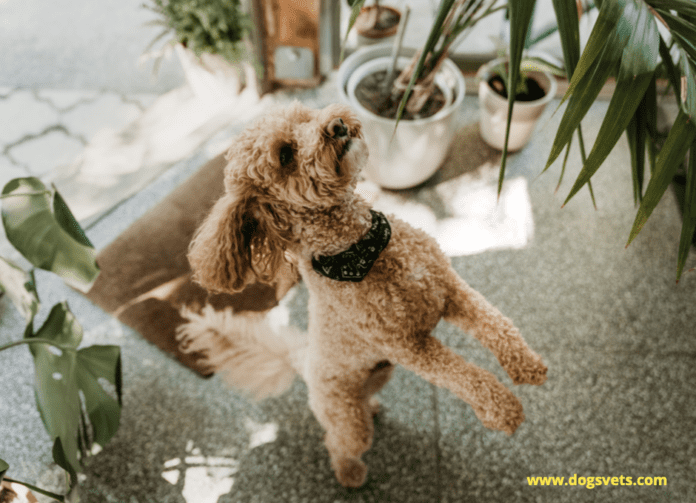Last Updated on March 18, 2024 by Dogs Vets
Pets And Plants: 7 Tips For A Harmonious Mix
Pets and plants can peacefully coexist in your home. However, you’ll need to go out of your way to ensure both are safe.
With your furry friend’s agility, they might mess up your plants or get ill if you don’t pay attention. The pets can nibble or chew your plant leaves and leave them unsightly.
Besides that, they can dig up soil from the plant’s pots and mess with your floor while also interfering with the plants’ growth. Thus, crafting ways to ensure your plants and pets coexist amicably is essential.
If you want to have the best of both worlds, consider these eight tips for a harmonious mix:
1. Use Non-Toxic House Plants
First, ensure that your plants don’t harm your pets. Out of curiosity, your pets will often gnaw on your blooms or leafy greens, regardless of whether they’re safe or toxic. They usually can’t tell the difference.
For example, some poisonous plants produce pollen which causes skin irritation if trapped in your pet’s coat. In addition, if your pets take in sap from toxic plants, they may get stomach upsets, vomiting, or diarrhea. In the worst-case scenario, your pets might die.
With this in mind, you’d want to grow pet friendly plants in your home. These include air plants, ponytails, spider plants, rattlesnake plants, polka dot plants, African violet plants, and mini money trees. All of these are pet-friendly, and they won’t cause harm to your pets.
2. Keep Your Plants Out Of Reach
Your pets are playful naturally, and there’s no doubt they’ll love to play around with your plants. That’s especially true if your plants’ leaves are dangling from the vases and swinging as the wind blows.
So, if your cat grabs the leaves and hangs on them like a monkey, the vase can overturn and break into pieces. Aside from that, they’ll spoil the plant’s green foliage or completely uproot the plants.
An excellent approach is keeping the plants out of reach by placing the pots on hanging baskets. Alternatively, you can keep your plants away from the walls, which helps them climb.
However, these two options will only be effective if your pets are young and haven’t mastered the art of jumping to higher heights. For bigger pets, you might need to employ other tactics.
3. Exercise Your Pets
Aside from the potential health benefits, exercising with your pets is also a great strategy to ensure your pets get tired and reduce their movements.
Consequently, they won’t have the energy and time to meddle with your indoor plants, thus allowing them to thrive.
You can involve them in tiring games such as hide and seek or throw and fetch. This exhausts them, and you’ll have potentially solved their agility issue. If you bring them indoors after such activities, they’ll be too tired to jump around and mess with your plants.
4. Cage Your Pets
If you reduce your pet’s mobility around the house, you reduce their chances of tampering with the plants. Thus, you can invest in cages or pet beds that stop your pets from moving around.
You have to ensure that the cells are clean and comfortable since they’ll spend a lot of time there. Also, you need to ensure they’re large enough to allow the pets to turn freely from side to side if they get tired of sleeping on one side.
Locking them up in the cages helps limit your pets’ movements within the house, meaning your plants will grow peacefully without interference.
5. Give Your Pets Safe Toys
Probably the reason why your pets play with your plants is that they have no toys to play with. Because of boredom, they resort to touching and grabbing anything within their reach, including your plants.
Remember, pets are typically playful, as long as they’re healthy and happy. You can capitalize on your pet’s playfulness with dog toys such as rubber toys, rope toys, stuffed toys, and tennis balls.
These are excellent for chewers. If you notice that they chew your plants, get them such toys. However, be on the lookout for torn or shredded toys. It would be best to replace them before they choke your pets.
6. Use Distraction Techniques
Another effective trick to keeping your pets from your plants is distracting them. You can use non-toxic sprays on your plants, such as the bitter apple spray, which prevents your pets from nibbling on the leaves.
Once they taste the bitterness, they’ll keep off from your plants thoroughly. Just remember to use pet-safe sprays. You’re distracting and not trying to harm your pets.
7. Train Your Pets
Training your pets requires patience and takes time. But in the end, it pays. You can teach them to stay away from your plants, just like you trained them on where to poop. You can use modern puppy training methods such as verbal commands whenever they go near your plants.
They’ll notice you disapprove of such behavior and eventually learn not to play around with your plants. If they obey your commands and avoid the plants, smother them with treats, constantly encouraging them to keep off.
Conclusion
You can create a harmonious environment for your pets and plants to thrive. You don’t have to choose and leave the other because both are essential to making a happy and appealing home.
For one, plants help purify the indoor air by taking in carbon dioxide and releasing oxygen. Secondly, having greenery within your home creates a relaxing effect, as your mind connects it with the nature outside.
On the other hand, pets are worthy companions, able to turn sad moments into happy ones.
For peaceful coexistence, the main idea is to direct the pets’ energy into other worthwhile activities, like exercising and playing with toys, thus keeping them off your plants.
Also, ensure that the plants you grow indoors don’t have harmful leaves and flowers.
Top 5 Questions About Pets and Plants:
1. Which houseplants are safe for pets?
Many common houseplants are toxic to pets if ingested. Popular safe options include spider plants, bromeliads, and ponytails. Be sure to research any plant before bringing it into your home if you have furry friends.
2. How do I keep my pet from digging up my plants?
Provide your pet with alternative digging spots filled with dirt or sand. Train them with positive reinforcement to stay away from plants. You can also use physical barriers like fencing or chicken wire around potted plants.
3. My pet keeps chewing on my plants! What can I do?
Chewing can be a sign of boredom or nutritional deficiencies. Offer your pet plenty of chew toys and address any underlying health issues. Bitter apple spray or citrus peels can deter some pets (be sure to test in an inconspicuous area first to avoid plant damage).
4. Can pets benefit from having plants around?
Absolutely! Plants can improve air quality, which is beneficial for both you and your pet. Some herbs like catnip can even provide enrichment for your furry friend (in moderation, of course!).
5. How do I create a space that works for both pets and plants?
Think vertically! Hanging plants and shelves keep greenery out of reach of curious paws. Place pet beds and toys in designated areas to distract them from plants.
Fact Check
We hope you enjoyed reading this article. What are your thoughts on the topic?
“At [Dogsvets.com], our goal is to bring you the most accurate and up-to-date information on all things pet-related.
If you have any additional insights or would like to advertise with us, don’t hesitate to get in touch.
If you notice any errors or discrepancies in our content, please let us know so we can correct them

















